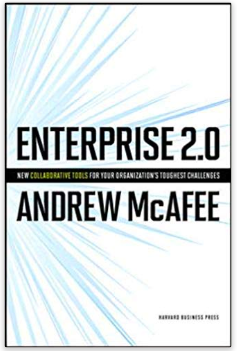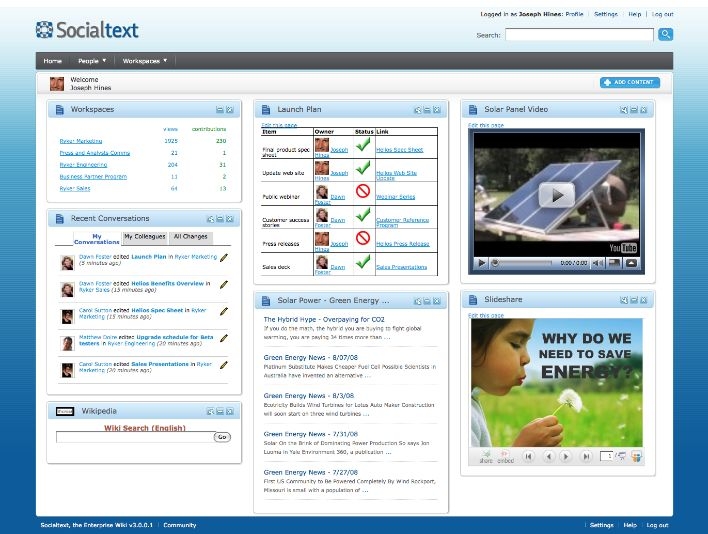 Last week was a banner 2.0 week for enterprise vendors. Gee. Do you think they were reading my blog? The week got off to a good start for me with a snappy little web 2.0 seminar hosted right here in Austin by IBM, “Web 2.0 Goes to Work.” Of course, SAP announced SAP By Design, but my fellow Irregulars did an awesome job conveying the import of that announcement.
Last week was a banner 2.0 week for enterprise vendors. Gee. Do you think they were reading my blog? The week got off to a good start for me with a snappy little web 2.0 seminar hosted right here in Austin by IBM, “Web 2.0 Goes to Work.” Of course, SAP announced SAP By Design, but my fellow Irregulars did an awesome job conveying the import of that announcement.  Like I said to Charlie Wood at lunch the other day, “I can’t even spell SAP…” So, I won’t attempt to comment on the SAP announcement. I’m scheduled to attend SAP’s TechEd Conference next week. We’ll see if I can be learnt.
Like I said to Charlie Wood at lunch the other day, “I can’t even spell SAP…” So, I won’t attempt to comment on the SAP announcement. I’m scheduled to attend SAP’s TechEd Conference next week. We’ll see if I can be learnt.
On the IBM gig, I was surprised, frankly, to find that both Rod Smith and David Barnes were both in attendance at this seminar and both presented. Smith wasn’t there for the whole shindig, but he was there to lend executive support to the the day. Smith related some anecdotal accounts of IBM’s experiences discussing 2.0 with key accounts. In general he said it’s easier to sit with lines of business now (as opposed to IT) to brainstorm ideas. With these new approaches, customers are willing to experiment more, even fail if need be, rather than wait for long, protracted 6-month development efforts that incorporate all the bells and whistles required to support the enterprise environment such as security, privacy, and compliance. Smith said, “That takes time, and [LOBs are] willing to take certain risks.” What I loved about Smith’s early discussions with IBM customers was the interest level about what was possible in the enterprise. He expressed the sentiment that customers want information to be “mashable, remixable…” that they started looking at their data as modular assets– using it in ways they hadn’t planned for. One example yielded an unexpected result when a mashup uncovered shipping information that helped a global distribution company combat piracy on the high seas.
After Smith and Barnes were done keynoting and introducing, for some reason, they made us all wear white lab coats (question mark?) and we self-sectioned off into three breakout sessions focused on each of the three main areas: collaboration, mashups, and IT integration with web 2.0 (my interpretation). I attended the first and the last, as I was having a private demo of QEDWiki in a few days. The collaboration session drew a mix of IBMers, customers, and partners. Questions ranged from, “How do I get people in my company to collaborate with these new tools?” to “How can we get access to data buried deep inside those web2.0-soulless mainframes?” Okay, well that was me asking that question. I had the good fortune to be sitting next to a veteran IBMer who said it IS possible to layer on interfaces to get access to all data in the enterprise so folks can collaborate on just about anything. The question then became– how willing would IT be to let the whole company have open and free access to that data? And round and round we went…
On the IT software integration session, my BSG colleagues were particularly engaged. IBM has packaged its offerings under the bundle, “Info 2.0.” It’s basically an integrated suite of technologies that enable the creation of mashable content. At present, I believe it includes what they’re currently calling DAMIA which transforms content into syndication feeds, the Mashup Hub where you discover, catalog, tag feeds for remixing and then syndicate content and then finally, QEDWiki which I’ve blogged about before and will later. They also have something called Ms. Rita (lovely Rita, “meter maid” in a too short uniform skirt that will never fly with corporate branding IMHO; sheesh, boys!) which is a configurable “utilization management service” to meter, monitor, and monetize web 2.0 an SOA components, applications or environments. Miss Rita (or, whatever) will probably not be available in the first release of the Info 2.0 announcement, not sure why. One fairly cool IBM application in beta right now is Many Eyes. Check it out for a free trial. If you want to see some of these tools in action check out some of these demos, podcasts, and videos.
Blogger transparency dictates that I confess I’m not qualified to comment on the technical intricacies of IBM’s foray into web 2.0, but I give Big Blue huge points for promoting web 2.0 in the enterprise. Like SAP, Oracle, and Microsoft, IBM has something the startups do not: a massive installed base. Even if only IBM puts some massive marketing muscle behind evangelizing, I kind of don’t care if their solutions and approach are a yawner. My sense is, they are serious about this sector for interesting economic motives that may possibly not be obvious to us right now. For instance, did it ever occur to anyone that “the cloud” is not really a cloud at all? Is IBM viewing the 2.0 transformation as an opportunity to reap big benefits from big iron? Just food for thought. Here are two pieces to ponder– one from the WSJ, one from CIO insight.
A few days after the seminar, I had the chance to revisit with Dan Gisolfi to see what he’s been up to lately with QEDWiki. Dan has teamed up with John Musser of Programmable Web. I will have more on that later this week, maybe tomorrow, as well as a report from an interesting meeting I attended with the local Social Media Club here in Austin.
 The news about Sarah Palin broke today while I was working. Where did I see the news? Twitter (of course). Seconds turned to minutes, and I found myself impatient with not knowing the inside scoop on the why behind the resignation. What was the target of my impatience? The Twitter community. Seems ridiculous, but it’s just expected these days that you’ll get to the heart of a breaking story within seconds.
The news about Sarah Palin broke today while I was working. Where did I see the news? Twitter (of course). Seconds turned to minutes, and I found myself impatient with not knowing the inside scoop on the why behind the resignation. What was the target of my impatience? The Twitter community. Seems ridiculous, but it’s just expected these days that you’ll get to the heart of a breaking story within seconds.

 Last week was a banner 2.0 week for enterprise vendors. Gee. Do you think they were reading my blog? The week got off to a good start for me with a snappy little web 2.0 seminar hosted right here in Austin by IBM, “Web 2.0 Goes to Work.” Of course, SAP announced SAP By Design, but my fellow Irregulars did an awesome job conveying the import of that announcement.
Last week was a banner 2.0 week for enterprise vendors. Gee. Do you think they were reading my blog? The week got off to a good start for me with a snappy little web 2.0 seminar hosted right here in Austin by IBM, “Web 2.0 Goes to Work.” Of course, SAP announced SAP By Design, but my fellow Irregulars did an awesome job conveying the import of that announcement.  Like I said to
Like I said to 